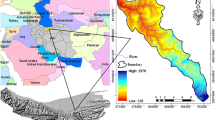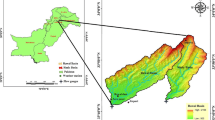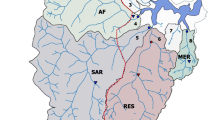Abstract
Watershed modelling was carried out in Sarida Catchment in the West Bank (Palestine) in order to determine the physical characteristics of the watershed. Generated storm water and runoff were estimated for watershed sub-catchments for enhancing the potentiality of rainwater harvesting development. Climatic data across eight years (seven wet seasons) were used for watershed modelling by using the software application systems of Watershed Modelling and Hydrologic Modelling. The Geographical Information System (GIS) and Microsoft Excel were used as well for the estimation of different model parameters and features. The physical and meteorological characteristics for each sub-catchment including land use, topography, soil, rainfall, and other parameters were identified. The model results provided sensitive conceptual principles for understanding the runoff mechanisms in the watershed. The average generated storm water over the seven seasons (2008/09 to 2014/15) is 23.16 and 13.44 Mm3/year for northern and southern sub-catchments in Sarida watershed, respectively. The generated runoff of the sub-catchments over this period ranged between 2.13 and 23.18 million cubic meters per year. The results suggest a high potential for rainwater harvesting to promote agricultural development and the need to establish a climatic monitoring network in Sarida watershed, as well as in other catchments in the West Bank, for better informing watershed management practices and policies.














Similar content being viewed by others
Data availability
The datasets generated during and/or analyzed during the current study are available from the corresponding author on reasonable request.
References
Alkhoury, W. (2011). Hydrological modelling in the meso scale semiarid region of Wadi Kafrein/Jordan-The use of innovative techniques under data scarcity.
Applied Research Institute – Jerusalem. (2011). The Status of Environment in the oPt – A Human Rights Based Approach. Bethlehem, Palestine.
Barnes, H. (1967). Roughness characteristics of natural channels, US geological Survey — Water supply paper. United States Government printing office.
Ghanem, M., Ahmad, W., Keilan, Y., & Sawaftah, F. (2017). Groundwater vulnerability mapping assessment of central West Bank catchments using PI method. Environmental Earth Sciences, 76(9), 347.
Issar, A. S. (2000). Water-The Past is the Key to the Future. The Water Resources of Israel, Past Present and Future. http://www.mideastwe.org/water3.html.
Izadi, M., Bahremand, A., Mohammadian Behbahani, A., Komaki, C. B., & Azarakhshi, M. (2020). Investigating the Effects of Lithological Units on Runoff Coefficient (A case study of 18 watersheds in three climatic regions of the Iran). Journal of Watershed Management Research, 11(21), 236-248. http://jwmr.sanru.ac.ir/article-1-987-en.html.
Judeh, T., Haddad, M., & Özerol, G. (2017). Assessment of water governance in the West Bank, Palestine. International journal of global environmental issues, 16(1-3), 119-134.
Land Research Center. (2008). Geopolitical situation in Salfit Governorate, Salfeet-West Bank. report, Ramallah, Palestine.
Maliwal, P. L. (2020). Text Book of Rainfed Agriculture and Watershed Management. Scientific Publishers.
Messerschmid, C., Sauter, M., & Lange, J. (2020). Field-based estimation and modelling of distributed groundwater recharge in a Mediterranean karst catchment, Wadi Natuf, West Bank. Hydrology and Earth System Sciences, 24, 887–917. https://doi.org/10.5194/hess-24-887-2020
Ministry of Agriculture. (2015). Ministry of Agriculture achieve data, soil and agricultural data. Ramallah, West bank.
Ministry of Agriculture. (2018). Ministry of Agriculture achieve data, Palestinian agricultural data. Ramallah, West bank.
Natural Resources Conservation Service. (2018). Economic benefits of applying soil health practices. United states Department of Agriculture - national water and climate centre.
Palestinian Meteorological Authority (PMD). (2016). Meteorological data for the West bank, Ramallah, West bank.
Palestinian Central Bureau of Statistics. (2016). Population in the West Bank by Governate and Sex, 2016. https://www.pcbs.gov.ps/Portals/_PCBS/Downloads/book1487.pdf.
Palestinian Water Authority. (2011). Annual status report on water resources, water supply, and wastewater in the occupied state of Palestine; PWA: Ramallah. Palestine, 2011, 97.
Ries, F. (2016). Runoff-recharge processes under a strong, semi-arid climatic gradient in the Eastern Mediterranean (Doctoral dissertation, Albert-Ludwigs-Universität Freiburg im Breisgau).
Shadeed, S. (2008). Up to date hydrological modeling in arid and semi-arid catchment, the Case of Faria Catchment, West Bank, Palestine. PhD thesis, Faculty of Forest and Environmental Sciences, Albert-Ludwigs-University, Freiburg, Germany.
Shadeed, S. & Masri, M. (2010). Application of GIS-based SCS-CN method in West Bank catchments, Palestine. Water Science and Engineering, Mar. 2010, Vol. 3, No. 1, 1–13.
Slayback, R., & Renney, C. (1972). Intermediate pits reduce gamble in range seeding in the Southwest. Journal of Range Management, 25(3), 224–227.
Thakur, J. K., Neupane, M., & Mohanan, A. A. (2017). Water poverty in upper Bagmati River basin in Nepal. Water Science, 31(1), 93-108.
Thawaba, S. (2006). Anthropogenic impact on water resources in the West Bank/Palestine: A case from Wadi Fara’a Stream—Nablus area. Environmental Forensics, 7(3), 241–245. https://doi.org/10.1080/15275920600840628
Wang, G., Mang, S., Cai, H., Liu, S., Zhang, Z., Wang, L., & Innes, J. L. (2016). Integrated watershed management: evolution, development and emerging trends. Journal of Forestry Research, 27(5), 967-994. https://doi.org/10.1007/s11676-016-0293-3
Weslati, O., Bouaziz, S., & Serbaji, M. (2020). Mapping and monitoring land use and land cover changes in Mellegue watershed using remote sensing and GIS. Arabian Journal of Geosciences, 13, 14.
World Bank. (2018). Securing water for development in West Bank and Gaza, International Bank for Reconstruction and Development/The World Bank 1818 H Street NW, Washington, DC 20433.
Acknowledgements
The authors are thankful to Dr. Anne Dare and her Middle East region water and sanitation expertise for editing the manuscript.
Author information
Authors and Affiliations
Corresponding author
Additional information
Publisher's Note
Springer Nature remains neutral with regard to jurisdictional claims in published maps and institutional affiliations.
Rights and permissions
About this article
Cite this article
Ghanem, M., Abu Sadah, M. & Keilani, Y. Watershed modelling development for generating runoff estimation of Sarida Catchment/Central West Bank. Environ Monit Assess 193, 672 (2021). https://doi.org/10.1007/s10661-021-09468-2
Received:
Accepted:
Published:
DOI: https://doi.org/10.1007/s10661-021-09468-2




